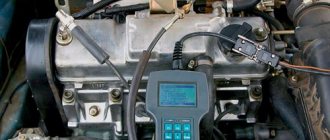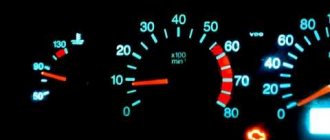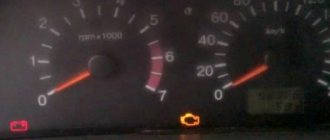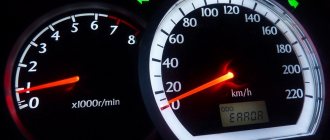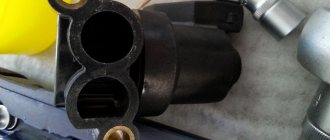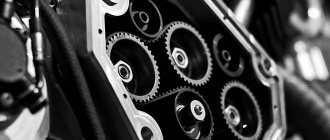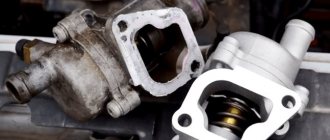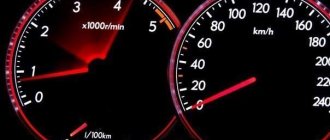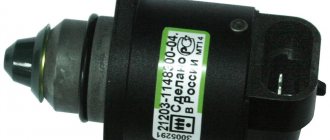How to cure a car?
First, you need to diagnose the fuel pump:
remove the cover from it and carefully inspect it visually, paying special attention to the area near the valve; If there is no o-ring, take corrective action.
In this case, the fuel pump depressurized and interruptions in the fuel supply began to occur. This is exactly what is causing the car to malfunction. After the seal is restored, the VAZ-21124 (16 valves) will begin to move smoothly along the road again. You can replace the O-ring yourself, the main thing is to find the right ring and tools.
Causes of poor speed gain
General view of the engine under the hood
So, let's look at what the problem is and where exactly you need to look for it:
- Fuel pump and pressure.
- Injectors.
- Fuel rail.
- Ignition system.
- Electronic control unit.
Now that all the causes are predetermined, you can begin sequential diagnosis and methods for solving the problem.
Options for solving the problem
To diagnose all of the above systems you will need a set of wrenches and screwdrivers, a tester, a little knowledge and hands growing from the right place. The main task remains to correctly distribute the sequence of operations. This is exactly what we will talk about next. So, let's look at where we need to go to remove the effect that has arisen.
Fuel pump, filter, rail and injectors
Fuel pump in the process of disassembly and diagnostics First of all, for diagnostics it is necessary to diagnose the gasoline module (pump). If the car drives at high speeds, then everything is fine with the pump itself, but the problem may lie in the filter mesh. For inspection, you will have to remove the fuel pump and replace the cleaning screen on it, which is primarily responsible for purifying gasoline. Most likely, it is dirty and needs to be replaced.
General view of the fuel filter
The second problem may be the fuel filter, which needs to be replaced. It is often dirty and needs to be replaced. After the first two elements of the fuel system have been replaced, you can try to drive it and see if the problem goes away.
General view of the fuel rail with injectors
If, nevertheless, the car continues to gain momentum poorly, then you need to crawl under the hood and look for the problem directly in the fuel injection system. To do this, you need to measure the pressure in the fuel rail.
To do this, dismantle the fuel rail with injectors and disassemble the assembly. The first element must be checked for leaks. Injectors are often installed on a special stand, cleaned and diagnosed. If necessary, all damaged elements are replaced.
Ignition
Unscrewing the spark plugs from the engine
If the fuel system has been checked and is working properly, then you need to look for a problem in the ignition system. So, the high-voltage wires are dismantled and the spark plugs are unscrewed. Both elements are checked using a tester. Of course, it is best to diagnose spark plugs on a special spark plug stand. As practice shows, the problem in 50% of cases lies precisely in this unit, so after checking it is necessary to replace the damaged elements. We conducted a special survey on the choice of candles.
ECU
ECU error codes
To eliminate the cause, you need to connect the laptop to the engine control unit and carry out diagnostics.
As practice shows, the problem is generally resolved by replacing the software. Instead of standard software, many motorists install Paulus products, although most simply reset the settings to factory settings.
Reading ECU errors using the instrument panel
content .. 12 13 14 15 ..Lada VAZ-2110 (2111, 2112). The engine does not develop full power
The car does not have sufficient throttle response. Jerks and dips when moving
| Blow or replace the air filter element | ||
| Increased resistance to gas movement in the exhaust system | Inspect the exhaust system for dented and damaged pipes, check the condition of the catalytic converter (back pressure) (service station) | Replace damaged exhaust system components |
| Suction of foreign air into the intake tract | Inspect the joints, check the fit of the throttle assembly, absolute pressure and air temperature sensors. Briefly disconnect the brake booster by plugging the intake manifold | Replace gaskets, O-rings, parts with deformed flanges, faulty vacuum booster |
| Incomplete throttle opening | Determined visually with the engine stopped | Adjust the throttle valve actuator |
| Low compression in the engine cylinders (less than 11.0 bar): wear or damage to valves, their guides and seats, stuck or broken piston rings | Check compression | Replace faulty parts |
| Disturbed valve timing | Check valve timing | Establish the correct relative position of the shafts. Check compression |
| The gaps between the electrodes of the spark plugs do not correspond to the norm | Check clearances | By bending the side electrode, set the required gap or replace the spark plugs |
| Heavy carbon deposits on the spark plug electrodes; ingress of carbon particles into the gap between the electrodes | Inspection | Check and replace spark plugs if necessary |
| Damage to the insulation of high-voltage devices and circuits | Using an ohmmeter, check for open or breakdown (short to ground) of the ignition coil windings and high-voltage wires | Replace damaged ignition coil, high-voltage wires |
| There is not enough fuel in the tank | By level indicator and fuel reserve indicator | Add fuel |
| The fuel filter is clogged, the water that has entered the power system is frozen, the fuel pipes are deformed | Check fuel system pressure | Replace the fuel filter. In winter, place the car in a warm garage and blow out the fuel lines. Replace defective hoses and tubes |
| The fuel pump does not create the required pressure in the system | Check the pressure in the fuel system, make sure the fuel module strainer is clean | Clean the fuel module strainer. Faulty fuel pump, pressure regulator, replace |
| Poor contact in the fuel pump power supply circuit (including ground wires) | Checked with an ohmmeter | Clean contacts, crimp wire ends, replace faulty wires |
| Faulty injectors or their circuits | Check the injector windings and their circuits with an ohmmeter (no open or short circuit) | Replace faulty injectors, ensure contact in electrical circuits |
| The air temperature sensor or its circuits are faulty | Check the sensor and its circuits | Restore contact in electrical circuits, replace the faulty sensor |
| The absolute air pressure sensor or its circuit is faulty | You can evaluate the performance of the absolute air pressure sensor using diagnostic equipment at a service station | Restore contact in electrical circuits, replace the faulty sensor |
| The oxygen concentration sensor is faulty | You can evaluate the performance of the oxygen concentration sensor and the reliability of its electrical circuit connections using diagnostic equipment at a service station | Restore damaged electrical circuits. Replace faulty sensor |
| The ECU or its circuits are faulty | To check the ECU, replace it with a known good one. | Replace the faulty ECU |
| The clearances in the valve drive are not adjusted | Check valve clearances | Adjust the clearances in the valve drive |
| Severe wear on the camshaft cams | Inspection during engine disassembly at a service station | Replace the worn camshaft at a service station |
| Loose or broken valve springs | Inspection during engine disassembly | Have the engine repaired at a service station |
| The throttle position sensor or its circuit is faulty | Check the throttle position sensor | Restore contact in electrical circuits, replace the faulty sensor |
| Coolant temperature sensor faulty | Check the sensor resistance at different temperatures with a tester | Restore contact in electrical circuits, replace the faulty sensor |
The engine does not develop full power
You need to pay attention to the loss of engine power when it goes beyond the 15 percent mark and if the car (in good condition) accelerates with difficulty on a flat, dry and hard road. There are plenty of reasons for this phenomenon, since in a machine, as in a living organism, everything is interconnected. The most common causes of power loss in a power unit
Early ignition
One of the elementary reasons for a decrease in engine power can be early ignition. In this case, the force of the exhaust gases goes against the movement of the piston due to the fact that the fuel mixture ignites prematurely. As a result, the engine cannot develop its full power. Delayed ignition also negatively affects vehicle speed. Here, on the contrary, the fuel mixture does not have time to burn until the moment when the piston reaches the dead center and the resulting energy is far from being fully used. The third reason may lie in a malfunction of the vacuum ignition timing regulator. Engine speed directly depends on how well the carburetor throttle valves are open. If the regulator diaphragm is damaged, it begins to function with great difficulty or fails altogether, which, in fact, immediately affects the power of the power unit
Also, the centrifugal ignition timing regulator may be to blame for the reduction in engine power, a malfunction of which leads to the problem described. As the engine speed increases, the centrifugal regulator begins to increase the ignition timing, but if its weights jam, the angle does not change throughout the entire operation of the engine and it loses its power. In this case, excessive fuel consumption is often observed due to early ignition, which occurs due to the rapid stretching of the weight springs. It is impossible to imagine the normal operation of the engine, and, accordingly, the combustion chambers, without the valves being tightly seated in the seats intended for them. Depending on the type of engine, the gap between the pusher shim and the end of the rod must be of a certain size. If the gap is increased, the tightness of the combustion chamber is compromised, which significantly reduces engine power. And with a reduced clearance, the valve edges and seats usually burn out. You can determine a loose fit by the shots: if a shot goes into the carburetor, this means that the intake valve does not fit tightly, and if a shot goes into the muffler, it means that the exhaust valve is not tight enough. Last but not least on the list is the cause of worn piston rings. In this situation, compression in the cylinders decreases, which immediately affects engine power. It is quite easy to determine whether rings are worn out. To do this, you need to remove the crankcase ventilation hose from the breather and if smoke comes out from there, it means the rings are worn out. The smoke resembles a dark stream with a pulse.
Insufficient filling of the cylinders with the working mixture
But what could be the reason for the decrease in engine power when the ignition is adjusted and the ignition timing regulators are working properly? In this case, you should check that the cylinders are full of the working mixture. Most often, this problem occurs due to the throttle valve sticking, so you sometimes need to pay attention to its drive. After this, you need to check the serviceability of the air filter, which, if necessary, is quickly removed and a new one is installed in its place. As practice has shown, a lack of working mixture in the cylinders can occur for four reasons: excessive carbon deposits in the engine cylinders; large deposits of coke and tar in the inlet pipe; sticking in the needle valve float chamber; using fuel with an octane number that does not match the number prescribed by the instructors.
Poor working mixture
The entry of a lean working mixture into the cylinders is also one of the reasons for the reduction in engine power. There are a number of reasons for the formation of a lean mixture, which can be eliminated fairly quickly: Air leaks at the junction of carburetor elements due to damage to the gaskets or due to loose fastenings. Transmission can be detected using soap suds. Where suction occurs, a void (window) is usually formed. Air leakage is removed by tightening the bolts and replacing sealing gaskets where required. Other reasons may be freezing of the liquid in the power system, contamination of the channels and jets in the carburetor, or contamination of the fuel lines. The situation can be corrected by blowing out the jets, fuel lines and channels using an ordinary pump used to inflate tires. If blowing does not give the proper result, then the carburetor must be disassembled and cleaned with copper wire. Clogging of the fuel pump air hole, wear of its drive lever and sticking of the air damper are the reasons for the formation of a lean mixture for the cylinders. These malfunctions are eliminated by replacing all non-working components of the fuel pump with new ones, cleaning the plug hole, and adjusting, if necessary, the length of the cable that controls the air damper. A small diaphragm breakthrough, sticking of the fuel pump valves and contamination of the strainer help create a working mixture. Problems are removed by washing the filter, restoring or replacing the diaphragm and eliminating stuck valves. It is worth knowing that sometimes a decrease in engine power occurs due to the influence of weather conditions. So, for example, in winter this problem occurs due to icing of the carburetor, and in summer the car loses speed due to a vapor lock or worn-out fuel pump. It turns out that the car owner can fix half of the problems on his own, but if there is no confidence in the correctness of his actions, then it is better to entrust this work to real professionals working at the service station.
Other reasons
Why doesn't the engine develop full power?
Lean mixture entering the cylinders. Filling the cylinders with a lean mixture always leads to a significant reduction in engine power. In this case, the car moves at reduced speeds; it takes more time to accelerate on a dry road with a hard and smooth surface when the vehicle’s chassis mechanisms are in good technical condition.
The reasons for the formation of a lean mixture are the following: clogged jets and channels in the carburetor, contamination of fuel lines, freezing of water in the power system. In this case, it is necessary to blow out the jets, channels and contaminated fuel lines using a tire inflation pump, and if necessary, clean them with copper wire by disassembling the carburetor;
stuck fuel pump valves, clogged strainer or ruptured diaphragm. In this case, first remove the stuck fuel pump valves, wash the strainer, and replace the broken diaphragm or temporarily restore it in the manner described earlier;
air leakage at the junction of carburetor parts, carburetor flange with exhaust pipe, intake pipe flanges with cylinder block due to loose fastenings, as well as damage to gaskets. The location of the leak can be detected using soap suds. A window will form in the soap suds at the expected location of the leak. Air leaks are eliminated by tightening nuts or bolts, as well as replacing the corresponding sealing gaskets;
wear of the fuel pump drive lever, clogging of the air hole connecting the fuel tank to the atmosphere, jamming of the air damper. These malfunctions are eliminated as follows: replace faulty parts of the fuel pump, clean the air hole of the plug, check and, if necessary, adjust the length of the carburetor choke control cable.
Late ignition. If the engine does not develop full power, then it is best to check the ignition installation. If the ignition is too late, the engine loses throttle response. A significant reduction in power occurs because the mixture does not have time to burn at the moment when the piston is at TDC. Combustion of the mixture continues as the piston moves downwards. This is evidenced by increased heating of the exhaust pipeline. It will be too hot because some of the mixture will burn when released.
Early ignition. A decrease in engine power also occurs when ignition is too early, when the combustible mixture ignites prematurely and the force of the gases acts against the piston, which moves towards TDC. At the same time, frequent and loud metallic knocks are heard in the engine, detonation may occur, the engine does not work well at low crankshaft speeds, and when started with the crank, it sometimes gives back knocks.
If by adjusting the ignition timing using the methods discussed earlier, it is not possible to achieve the desired results, then, obviously, malfunctions have arisen in the devices for automatically adjusting the ignition timing - centrifugal or vacuum regulators.
The vacuum ignition timing regulator is faulty. On the way, the car has to move both on a flat road and on a road with inclines. Let's assume that when driving at a constant speed both on a flat road and on an uphill road, the centrifugal regulator will only provide the same ignition timing. But when driving on a hilly road, the engine load and throttle opening are much greater, so the ignition timing must be less than when driving on a flat road at the same speed.
Violation of clearances in the valve mechanism. It is known that a tight fit of the valve in the seat, i.e. its complete closure, is ensured due to the thermal gap in the valve mechanism. If the normal values of thermal clearances established by the requirements of the factory operating instructions for vehicles are violated, the engine loses power. With small gaps, valves and their seats burn out. The presence of large gaps in the valve mechanism causes not only a loss of engine power, but also a characteristic metallic knocking sound of the valves. In addition, loose closure of, for example, an exhaust valve due to abnormal clearances is characterized by “shots” in the muffler, and a loose fit of the intake valve is characterized by “sneezing” in the carburetor.
Both small and large clearances in the valve mechanism negatively affect not only the efficiency of the engine, but also the service life of its parts. Abnormal clearances in the valve mechanism are adjusted in the manner discussed earlier.
Wear of piston rings. Piston rings provide a tight seal between the piston and cylinder, preventing gases from escaping into the engine crankcase, and also prevent oil from penetrating into the combustion chamber.
When the piston rings wear out (burning of the rings in the piston grooves, loss of their elasticity), compression in the cylinders sharply decreases, which leads to loss of engine power, increased oil and gasoline consumption; Black smoke comes out of the muffler.
Compression in the engine cylinders is checked using a compression gauge and manually.
Contamination of the muffler. During the operation of the car, due to the engine running on a too rich mixture, incomplete combustion occurs. Unburnt fuel is thrown out in the form of soot, and part of it settles on the inner wall of the muffler, gradually contaminating it. In addition, contamination of the muffler is also possible when the vehicle is carelessly reversing on a bumpy dirt road. If the muffler is dirty, the engine loses power. The condition of the muffler can be determined by external inspection and a light blow from the outside. A clean muffler produces a high-pitched metallic sound, while a dirty muffler produces a dull sound.
A dirty muffler must be cleaned, as this leads not only to loss of engine power, but also to excessive consumption of gasoline, as well as premature wear of the muffler.
content .. 12 13 14 15 ..
Main reasons
There are many reasons for this phenomenon and in most cases they are associated with a malfunction of the systems and mechanisms of the power plant.
Some of them are trivial and very easy to fix, others require quite serious repairs.
The main problem with the fact that the engine does not pull is not related to eliminating the malfunction, but to finding it.
In some cases, it is very difficult to determine what caused the reduction in traction effort and you have to go through almost the entire engine.
Therefore, we will try to indicate the main reasons why the car accelerates very “sluggishly”.
Since engines on different cars have their own design features, we will consider specific models.
Other reasons
Finally, we note that some reasons are very rare and can be considered specific.
These include loosening the exhaust manifold, although initially it may seem that this cannot affect the engine.
In fact, on many cars, heat from the manifold is used to warm up the air entering the cylinders, and for this purpose a special screen is used, to which the air duct fits.
So, if a breakdown occurs and the exhaust gases break out, then most of them will enter the cylinders again through the air duct, and due to a lack of air, the power will decrease.
Also, the reason may lie not in the engine, but in the transmission elements, especially for cars equipped with automatic transmission.
Malfunctions in the box lead to the creation of excessive load on the engine, which will be perceived as a loss of power.
On diesel
Some of the reasons for power loss listed above are also relevant for diesel engines. But there are also a number of specific points associated with diesel engines that should be mentioned. One of the most common causes of power loss in a diesel engine is the failure of the turbocharger. When this unit fails, it usually begins to emit a characteristic whistle, which is difficult to confuse with something else. But in order to accurately determine the breakdown, you will have to send the car to a car service center. There they will scan it and identify the problem. Why might the turbo turn off? Here are some options.
- The charge air pressure sensor has failed.
- The turbine has simply exhausted its factory life.
- The tightness of the joint between the compressor and the motor is broken.
- The air path is clogged.
- The turbocharger axis has become coked, causing its rotation to slow down.
- The turbocharger shut-off valve has failed.
A characteristic external sign of a compressor failure is blue smoke coming out of the exhaust pipe.
It occurs due to the combustion of oil, the excess of which enters the combustion chambers of the cylinders due to leaks in the compressor. If the tightness of the compressor discharge line is broken, air leaks occur and the mixture becomes too rich. When it burns, not blue smoke comes out of the chimney, but black smoke. Finally, white smoke indicates that the oil line through which oil is drained from the compressor is clogged.
Why is it stupid? Basic faults
Type of VAZ-2112 engine
There are not many reasons for the effect when the 16-valve engine on the VAZ-2112 16 valves stalls. Of course, you will have to tinker a little in order to find the true reason in one case or another, but otherwise there is a direct road to a car service center. For those who have decided to repair their car themselves, this information will be useful.
So, let's look at the main reasons for this effect:
We clean the sensor from dirt and dismantle it.
The main reasons are considered, and you can move on to solving these problems.
Methods for solving the problem
To eliminate failure during overclocking, you need to check all the components listed below step by step. This is a considerable amount of work, but the car enthusiast will be able to save a sufficient amount of money, which would have been charged to him at a car service center. Of course, for those who don’t understand the design of a car, that’s the way to go, or ask your friends who will fix the problems for half the price. But, if you follow the instructions, you can figure it out yourself.
Poor quality fuel
Poor quality fuel is a common cause of engine breakdowns
Of course, in our country, low-quality fuel causes many misfortunes and troubles for motorists. It is not possible to check the fuel at a gas station, so everyone is already struggling with the consequences. The only thing that can be done is to carry out regular diagnostics and cleaning of the fuel system.
Fuel system
Injectors on the fuel rail removed from the engine
The first line of engine protection is fuel filters, which sometimes fail and not enough fuel gets into the engine. On the other hand, when completely clogged, the injectors are clogged, which at low speeds give a normal amount of mixture, but if the engine is accelerated, the amount of mixture remains the same and a failure appears at low speeds.
The way out of the situation is to replace the fuel filter, clean or replace the gasoline pump mesh, and diagnose and replace failed injectors. The latter usually go through a cleaning stage, but this does not always help and they have to be replaced.
Throttle valve
Cleaned throttle body
A stuck throttle valve and insufficient air supply can cause the engine to become sluggish when accelerating. This is due to a non-optimal fuel mixture. In this case, the solution to the problem is cleaning.
Problems with air supply to the engine
A common reason for poor engine speed can be poor air supply to the engine, because air is needed to prepare the combustible mixture, which sets the engine pistons in motion.
VAZ-2110 engine cooling system: 1 - expansion tank; 2 — radiator outlet hose; 3 - radiator; 4 — radiator steam outlet hose; 5 — radiator supply hose; 6 — casing of the electric fan of the cooling system; 7 — thermostat housing; 8 — coolant temperature sensor of the engine management system (installed in the exhaust pipe); 9 — exhaust pipe; 10 — coolant temperature sensor for the instrument cluster (installed in the cylinder head); 11 — cylinder head; 12 — throttle assembly; 13 — bracket for fastening the supply pipe of the coolant pump; 14 — coolant pump; 15 — supply pipe of the coolant pump; 16 — heater radiator supply hose; 17 — heater radiator outlet hose; 18 — steam removal hose of the heater radiator; 19 — coolant pump supply pipe hose; 20 - filling hose.
If too much air is supplied to the engine, the mixture in it becomes too saturated with oxygen, and the percentage of gasoline in the mixture, on the contrary, drops.
The most optimal and simple method of solving such a problem may be to purchase and install a new air filter. To prevent a similar problem in the future, it is necessary to replace the air filter in the engine 2 times a year.
Malfunctions of the power supply system, ignition and impaired mixture formation
While problems with spark plugs and filters can be identified on the road, more serious problems associated with the power and ignition system are much more difficult to diagnose and fix on site. In cases where the engine does not pick up speed, and jerks and dips are noted when pressing the gas pedal, it is necessary to check and adjust the carburetor or injector.
Let's focus on the more common electronic injection. The list of main malfunctions of modern injection internal combustion engines includes:
- malfunctions, decreased performance or contamination of the fuel pump mesh filter;
- malfunction of injection nozzles;
- problems with ECM or ECU sensors;
- ignition system malfunctions;
- air leaks and leaking fuel lines;
Often, on many cars, problems are associated with the fuel pump, which is located in the gas tank, as well as with the specified regulator. To measure fuel pressure, a pressure gauge is connected to the rail; the obtained values are compared with those recommended for a particular engine. If the pressure is below normal, then the culprit may be either the fuel pump or the pressure regulator.
The regulator's task is to discharge excess fuel into the return line at a time when the pressure is higher than normal. If the settings are incorrect or the regulator itself is leaking or faulty, then the fuel will be discharged into the return line ahead of time. To check this, air is pumped in with a compressor or pump, and the pressure in the rail increases. If the regulator operates earlier than the recommended pressure, the element must be adjusted or replaced.
Power drop on a VAZ carburetor engine
To begin with, let's take VAZ cars with a carburetor power system and an 8-valve timing system - VAZ-2109, VAZ-2110, VAZ-2114, VAZ-2115.
The same power plant is installed on these cars, so the reasons are identical.
Let's go through those components, due to malfunction of which a drop in dynamics may occur.
In general, the main reason that the engine does not pull is a change in the processes in the combustion chambers - a mismatch in the proportions of the air-fuel mixture, the combustion process is disrupted, the filling of the cylinders and the removal of exhaust gases does not occur as required.
Supply system
Very often, a drop in traction occurs due to the power system. Structurally, the carburetor fuel system used on cars from VAZ-2109 to VAZ-2115 is very simple and is almost completely mechanical, so identifying the cause is not particularly difficult.
A decrease in power can occur due to:
- Severely clogged fuel filter (its throughput drops and the pump is simply not able to pump the required amount of fuel);
- Contamination of the carburetor channels (the jets and fuel channels in this element have a small cross-section and debris often clogs them);
- There is air leakage in the area from the tank to the pump (because of this, the performance of the fuel pump drops sharply);
- Damage to the fuel pump membrane (a small crack in it leads to the fact that the vacuum required for pumping fuel is not created in the pump chambers);
- The fastening of the carburetor or intake manifold is loose (due to this, air leaks around the carburetor and the proportion of the air-fuel mixture is greatly disturbed);
- The hole in the fuel tank cap is clogged (because of this, a vacuum is created in the tank and it is much more difficult for the gas pump to pump gasoline out of it);
In addition to the elements responsible for supplying fuel, a drop in power also occurs due to severe contamination of the air filter element.
Ignition system
This system also takes part in the combustion of the mixture, which means a failure in its operation can affect power.
In carburetor engines VAZ-2110 and others, a decrease in traction can occur due to:
- Faulty spark plugs or changes in their thermal gap;
- Excessive wear of the contacts and the central electrode of the distributor;
- Voltage losses in high-voltage wires;
- Violations of the ignition timing.
Irregularities in the power supply and ignition systems most often cause a drop in power, so testing to identify the cause should begin with them.
If the operation of these systems does not raise suspicions, other components of the engine should be diagnosed.
Exhaust system, timing belt and crankshaft
Loss of traction can also occur due to the exhaust gas removal system, although problems with it rarely occur on carburetor engines.
The main reason here is the reduction in throughput due to large deposits in the muffler. Because of this, exhaust gases, without having time to escape from the cylinders, “choke” the engine.
The reasons for the drop in thrust are also often the gas distribution mechanism and the cylinder-piston group.
Here the reduction in power occurs due to:
- Violations of the thermal clearance of valves;
- Heavy carbon deposits on the valve plates and seats, or their burning;
- Occurrence of rings;
- Limit wear of the CPG;
- Cylinder head gasket failure.
In general, problems with the timing belt and CPG cause a drop in power in any engine - carburetor, injection, diesel. Therefore, we will not mention these mechanisms further.
Causes of poor speed gain
General view of the engine under the hood
So, let's look at what the problem is and where exactly you need to look for it:
- Fuel pump and pressure.
- Injectors.
- Fuel rail.
- Ignition system.
- Electronic control unit.
Now that all the causes are predetermined, you can begin sequential diagnosis and methods for solving the problem.
Options for solving the problem
To diagnose all of the above systems you will need a set of wrenches and screwdrivers, a tester, a little knowledge and hands growing from the right place. The main task remains to correctly distribute the sequence of operations. This is exactly what we will talk about next. So, let's look at where we need to go to remove the effect that has arisen.
Floating speed: reasons
Note that in some cases the revolutions do not just slowly fall or remain at the same level, but “float”. In this case, the engine may become unstable. Floating speeds first fall, then increase sharply and everything repeats. A common cause of this phenomenon is the supply of excess air, which leads to “jumps” in speed.
Such problems arise if the air supply sensor (MAF) fails, which allows the ECU to calculate how much air is supplied and how much fuel is supplied to prepare the required mixture.
If malfunctions occur, the control unit cannot prepare the “correct” mixture for the idle mode, which causes speed jumps after releasing the gas pedal or when the engine is idling.
Sensors and their malfunctions
Separately, it should be said about the VAZ-2110-2112 sensors. Their number has increased significantly after the use of an injection power supply system for power plants. Each sensor must be reported separately.
Crankshaft position sensor.
This sensor is quite reliable and rarely fails. But if it does, there are a number of signs indicating this.
If the sensor is not working, the power unit starts poorly, operates unstably, the unit itself loses power and detonation occurs during operation. Problems with the performance of the sensor are eliminated by replacing it.
Throttle sensor.
Another sensor that is used on cars of the 10th family is the throttle position sensor.
If this sensor fails, problems with the engine begin in different operating modes. Thus, at idle, the engine speed may increase, the engine may periodically stop while changing gears, and the speed may become unstable in all operating modes.
We also do not repair the throttle position sensor and, if it malfunctions, we replace it.
Mass air flow sensor.
If it is clogged, it can also have a significant impact on the operation of the power plant.
Problems with this sensor result in increased fuel consumption, difficult starting when the engine is warm, and loss of dynamics and power.
Most often, the mass air flow sensor “suffers” from deposits that crankcase gases can cause on it.
Because of this, this sensor fails more often than others, but you can first try to restore it by cleaning it. And only after cleaning does not help, it is replaced.
Knock sensor.
The knock sensor is also responsible for the behavior of the power plant. If this sensor malfunctions, a loss of power also occurs, the installation itself may “tweak”, and the dynamics of the car will decrease.
The functionality of this sensor cannot be restored; if it malfunctions, it is replaced.
RXX.
The idle speed regulator is responsible for controlling the operation of the power plant.
Its malfunction always results in unstable engine speeds in different operating modes, but primarily at idle.
In general, malfunctions of this sensor are often confused with a malfunction of the throttle position sensor, but there is one difference.
If the latter malfunctions, a “Check engine” signal may appear. And if the idle air control is broken, this signal does not appear.
As with the mass air flow sensor, the regulator may become clogged with products found in the crankcase gases. But unlike the mass flow sensor, the regulator is not cleaned, it is simply replaced.
Oxygen sensor.
The last sensor used in the power plant of VAZ-2110-2112 cars is an oxygen sensor, also known as a lambda probe, how to check it, read here https://autotopik.ru/diagnostika-neispravnostei/609-kak-proverit-lyambda-zond. html.
It can be damaged by carbon deposits that form on the surface of the sensor head. As a result, the engine will operate unstably, consumption will increase, etc. Replacing it will not be difficult.
Speed sensor.
There is another sensor that is not related to the power plant - this is the speed sensor.
It is located on the gearbox.
He is responsible for the speedometer and odometer readings. The reliability of this sensor is low, and the malfunction is manifested by incorrect speedometer readings.
As for the electrical part of the car, the weakest parts of the VAZ 2110 - 2112 are the generator and window lifting mechanisms.
The generator in these cars rarely lasts more than 60 thousand km.
Generator malfunctions manifest themselves in the cessation of power supply to the vehicle’s on-board network.
They are often eliminated only by replacing it, although some elements of the latter can still be repaired.
Read on the topic: Do-it-yourself generator repair.
Where are the IAC and TPS sensors located?
So, first, let's check the IAC sensor. It is located on the throttle assembly below the TPS sensor. Dismantling it is very simple - remove the block from the sensor and use a Phillips screwdriver to unscrew the two bolts securing it. Then we pull out the sensor or perform diagnostics on it, read about this below.
The throttle position sensor is located above the IAC and is also secured with two bolts. It unscrews quite easily; there is no need to remove either the pipe or the throttle itself. Disconnect the block, unscrew the two bolts and pull out the sensor.
Causes of poor speed gain
General view of the engine under the hood
So, let's look at what the problem is and where exactly you need to look for it:
- Fuel pump and pressure.
- Injectors.
- Fuel rail.
- Ignition system.
- Electronic control unit.
Now that all the causes are predetermined, you can begin sequential diagnosis and methods for solving the problem.
Options for solving the problem
To diagnose all of the above systems you will need a set of wrenches and screwdrivers, a tester, a little knowledge and hands growing from the right place. The main task remains to correctly distribute the sequence of operations. This is exactly what we will talk about next. So, let's look at where we need to go to remove the effect that has arisen.
Fuel pump, filter, rail and injectors
Fuel pump in the process of disassembly and diagnostics
First of all, for diagnostics it is necessary to diagnose the gasoline module (pump). If the car drives at high speeds, then everything is fine with the pump itself, but the problem may lie in the filter mesh. For inspection, you will have to remove the fuel pump and replace the cleaning screen on it, which is primarily responsible for purifying gasoline. Most likely, it is dirty and needs to be replaced.
General view of the fuel filter
The second problem may be the fuel filter, which needs to be replaced. It is often dirty and needs to be replaced. After the first two elements of the fuel system have been replaced, you can try to drive it and see if the problem goes away.
General view of the fuel rail with injectors
If, nevertheless, the car continues to gain momentum poorly, then you need to crawl under the hood and look for the problem directly in the fuel injection system. To do this, you need to measure the pressure in the fuel rail.
To do this, dismantle the fuel rail with injectors and disassemble the assembly. The first element must be checked for leaks. Injectors are often installed on a special stand, cleaned and diagnosed. If necessary, all damaged elements are replaced.
Ignition
Unscrewing the spark plugs from the engine
If the fuel system has been checked and is working properly, then you need to look for a problem in the ignition system. So, the high-voltage wires are dismantled and the spark plugs are unscrewed. Both elements are checked using a tester. Of course, it is best to diagnose spark plugs on a special spark plug stand. As practice shows, the problem in 50% of cases lies precisely in this unit, so after checking it is necessary to replace the damaged elements. We conducted a special survey on the choice of candles.
ECU error codes
To eliminate the cause, you need to connect the laptop to the engine control unit and carry out diagnostics.
As practice shows, the problem is generally resolved by replacing the software. Instead of standard software, many motorists install Paulus products, although most simply reset the settings to factory settings.
Solving the problem of deteriorating vehicle traction
ZMZ-409 engineZMZ 409 engine In any case, the problem of a drop in vehicle power cannot be ignored. Having made itself felt today, it will progress every day and cause more and more inconvenience and will ultimately damage the engine. Timely computer diagnostics and a thorough inspection of the machine by a qualified specialist will help you get rid of the problem.
Replacing spark plugs, high-voltage wires, and an air filter can, of course, be done on your own if the need arises. But if, after installing new parts, the behavior of your personal vehicle has not changed for the better, it is worth sending it for diagnostics to a specialized service, where experienced technicians will diagnose the cause of the deterioration in traction of your car.
Why does the VAZ-2112 16 valves get stuck when accelerating when hot: reasons
Repeatedly, many drivers were faced with the fact that the 16-valve VAZ-2112 began to become dull during acceleration or a drop in speed was felt. This may be due to various reasons that you need to know how to eliminate.
The video shows the process when a VAZ-2112 was tripping, did not pick up speed well, the check engine light came on periodically, and a solution:
Why is it stupid? Basic faults
Type of VAZ-2112 engine
There are not many reasons for the effect when the 16-valve engine on the VAZ-2112 16 valves stalls. Of course, you will have to tinker a little in order to find the true reason in one case or another, but otherwise there is a direct road to a car service center. For those who have decided to repair their car themselves, this information will be useful.
So, let's look at the main reasons for this effect:
The main reasons are considered, and you can move on to solving these problems.
Methods for solving the problem
To eliminate failure during overclocking, you need to check all the components listed below step by step. This is a considerable amount of work, but the car enthusiast will be able to save a sufficient amount of money, which would have been charged to him at a car service center. Of course, for those who don’t understand the design of a car, that’s the way to go, or ask your friends who will fix the problems for half the price. But, if you follow the instructions, you can figure it out yourself.
Poor quality fuel
Poor quality fuel is a common cause of engine breakdowns
Of course, in our country, low-quality fuel causes many misfortunes and troubles for motorists. It is not possible to check the fuel at a gas station, so everyone is already struggling with the consequences. The only thing that can be done is to carry out regular diagnostics and cleaning of the fuel system.
Fuel system
Injectors on the fuel rail removed from the engine
The first line of engine protection is fuel filters, which sometimes fail and not enough fuel gets into the engine. On the other hand, when completely clogged, the injectors are clogged, which at low speeds give a normal amount of mixture, but if the engine is accelerated, the amount of mixture remains the same and a failure appears at low speeds.
The way out of the situation is to replace the fuel filter, clean or replace the gasoline pump mesh, and diagnose and replace failed injectors. The latter usually go through a cleaning stage, but this does not always help and they have to be replaced.
Throttle valve
Cleaned throttle body
A stuck throttle valve and insufficient air supply can cause the engine to become sluggish when accelerating. This is due to a non-optimal fuel mixture. In this case, the solution to the problem is cleaning.
Ignition system
High voltage wires of the ignition system
Another reason that the car began to stall while accelerating could be interruptions in the ignition. So, it is necessary to check the spark plugs and high-voltage wires where breakdowns could occur. If necessary, damaged parts must be replaced. The manufacturer recommends replacing everything in sets.
ECU errors
List of electronic control unit errors
The last problem is that errors occur in the electronic engine control unit. If there is a large accumulation of errors, this can affect the operation of various vehicle systems. Therefore, as practice shows, resetting ECU errors leads to normalization of the operation of the power unit.
Self-diagnosis mode of the instrument panel on the VAZ-2112
conclusions
Eliminating the effect when a 16-valve VAZ-2112 stalls during acceleration turns out to be not so difficult with your own hands. Of course, if you are unable to fix the problem, you should go to a car service center, where they will do everything quickly and accurately.
carfrance.ru
The engine does not pull: the main reasons for the decrease in engine power
So, if no other symptoms other than loss of traction are detected, then you immediately need to pay attention to the quality of the fuel, the proper functioning of the ignition and power systems. As practice shows, more than half of the cases of reduced efficiency from internal combustion engines are associated with fuel
The engine does not turn on due to the fact that the tank may be filled with low-quality or unsuitable fuel for this type of engine (for example, 92-grade gasoline instead of 95-grade gasoline)
As practice shows, more than half of the cases of reduced efficiency from internal combustion engines are associated with fuel. The engine does not turn on due to the fact that the tank may be filled with low-quality or unsuitable fuel for this type of engine (for example, 92-grade gasoline instead of 95-grade gasoline).
In some cases, after refueling, problems may also arise with starting the engine,
detonation
engine. To solve this problem, it is often enough to dilute the existing fuel with a higher quality one. Less often, it becomes necessary to completely drain the fuel from the tank, after which additional flushing of the power system is performed.
Typically, such manipulations are necessary when, parallel to the loss of traction, unstable operation of the internal combustion engine is noted, the speed jumps or floats at idle and under load, the engine does not start easily, the “check” light is on the panel, etc.
Also, owners of gasoline engines can independently determine the quality of gasoline by the spark plugs and their appearance. To check the spark plugs you need to unscrew them from the engine. A disruption in the combustion process of the fuel-air mixture in the cylinders, as well as the presence of impurities in the fuel, can be identified by soot on the spark plugs and its color.
For example, if the fuel contains a lot of third-party metal-containing additives and additives, then the skirt and electrodes may become covered with reddish soot (brick-colored). Black soot will indicate that the fuel is not burning properly, etc. In any case, malfunctions in the combustion process of the working mixture lead to the fact that the engine stops pulling.
The next step in diagnosis is checking the spark plugs. A decrease in the efficiency of these elements is also accompanied by a decrease in the power of the power unit.
This is especially noticeable during sharp accelerations, and when the car is already moving at high speed. In other words, the motor has no “reserve” left for further acceleration.
The candles may be dirty, and it is also possible that their life has come to an end. To fix this problem, you can clean the spark plugs or immediately replace the entire set with a new one.
It is important to take into account that if new spark plugs are correctly selected for a specific engine in terms of heat rating and other parameters, but still quickly become dirty, then the reason for the loss of traction is not in them. The formation of carbon deposits in this case indicates problems with mixture formation or combustion of the fuel charge in the cylinders
If everything is in order with the spark plugs, then you need to check the condition of the fuel and air filters. In the first case, insufficient throughput can lead to the fact that the required amount of fuel is not supplied to the cylinders to prepare the so-called “power” mixture.
As a result, the engine loses power, that is, it does not pull under load. In such a situation, it is enough to replace the specified filter element. As for the air filter, the problem is similar to the fuel filter, but in this case there is a lack of air in the fuel-air mixture.
This leads to the fact that fuel without a sufficient amount of oxygen burns incompletely. In such conditions, engine power naturally drops, carbon deposits form in the combustion chamber, spark plugs become increasingly dirty, etc. To solve the problem, the engine air filter also needs to be replaced.
If the diesel engine doesn't work
A decrease in traction can also occur in diesel engines. If we look at old cars that have completely mechanical power systems, then the most common cause is depressurization of the system.
As a result, air enters the fuel, which is why the fuel injection pump is unable to provide the required pressure.
Don't forget about:
- clogged filters;
- weakly pumping fuel priming pump;
- damaged plunger pair;
- Coking of injector nozzles.
And if we also add possible problems with the timing belt and CPG, then identifying the cause will not be so easy.
In modern diesel installations, where an additional electronic component is used, the search range will increase.
For example, the Common Rail system uses all the same sensors as the injection engine. And if at least one of them breaks, this will certainly affect the operation of the control part.
VAZ injection engines
In injection engines VAZ-2110, 2112, 2114, 2115, both 8-valve and with a timing belt with 16 valves, it is more difficult to identify the cause of the decrease in power due to the more complex design of the main systems.
Supply system
Any injector consists of a mechanical executive part and an electronic control part, and problems can arise in both of them, which will lead to a drop in power.
Let's look at the mechanical part first. Here, cravings can be influenced by:
- Severely clogged mesh filter on the fuel pump;
- Decrease in fuel pump performance due to wear;
- The fine filter is dirty;
- Malfunction of the fuel rail pressure regulator;
- Clogged injectors;
- Fuel filter dirty;
- Air leak in the manifold.
In general, almost every element of the injector executive part can be the culprit for a decrease in dynamics.
The situation is approximately the same in the electronic component.
The operation of the engine with the injector is controlled by an electronic unit, which constantly monitors the parameters through sensors installed on different systems.
The number of these tracking elements is considerable and the breakdown of any of them leads to the fact that the ECU incorrectly evaluates the indicators on the basis of which it controls the executive part.
Thus, the lambda probe, DPKV, mass air flow sensor, DPZ, phase sensors, detonation sensors and coolant temperature sensors in the event of a breakdown lead to a decrease in power, so you will have to check all of them in search of the cause.
Causes
There may be several reasons for the lack of proper speed gain:
- There are problems with the air supply;
- The ignition has failed;
- Fuel system malfunctions have occurred;
- There were problems with the exhaust system.
Fuel system problems are common in gasoline engines. They are the most common. Therefore, you should start with checking it.
Fuel system
If problems arise when accelerating the car, start checking by inspecting the fuel system.
- Most often, the engine stops gaining momentum because the fuel pump fails. At first, this may have a slight effect, sometimes unnoticed. Over time, as the pump wears out, the speed and power will begin to drop, and the acceleration dynamics will decrease.
- If the fuel pump is partially damaged, it still partially performs its functions, but is no longer capable of delivering the same volumes of fuel. This results in fuel starvation and power loss.
- The best solution to a problem with the pump is to replace it. It is better to trust repairs to specialists.
Ignition
If the ignition fails, you will have to conduct a comprehensive check of all system components that may cause a drop in engine power and speed.
What to check
Peculiarities
Checking timing marks
If the marks are installed incorrectly, fuel will not be injected in a timely manner, and the correct frequency of spark supply will be disrupted.
You will have to check all the sensors that take part in the operation of the ignition system
Pay special attention to the crankshaft and camshaft position sensors. A regular test allows you to quickly determine whether the sensors are really to blame
If the belt has been in use on your vehicle for a long time, it may be at the end of its service life. Or it was installed incorrectly when replacing it. After all, it is enough to make a mistake by one tooth, and the performance of the car will be impaired, the car will not be able to accelerate properly
In some cases, they do not allow the car to start at all if there is a malfunction, but sometimes they lead to a noticeable drop in power. Remove them, check their condition, clean them, measure the distance between the electrodes. If they fail, simply replace them with new ones.
To finally verify the presence or absence of problems in the ignition system, it is recommended to conduct more detailed diagnostics.
Main reasons with engines of other cars
Next, we will go through other cars, and we will indicate the most frequently occurring problems that lead to a drop in power.
So, on a Mitsubishi Lancer 9, the problem most often arises with the exhaust gas exhaust system. This car uses a double catalyst, which becomes clogged with carbon deposits relatively quickly.
Therefore, many owners of this car, when the power drops, recommend first of all paying attention to this system.
But in the ZMZ-406 and 405 engines, which are equipped with GAZelle and Volga cars, a drop in power often occurs due to:
- Ignition coil malfunctions;
- Losses in high-voltage wires;
- Non-working spark plugs;
- Failure of sensors (primarily DPKV).
But do not forget about the other above-mentioned elements of the power supply, ignition, as well as timing and CPG systems.
In Ford Focus cars, in general, problems with loss of traction arise due to malfunctions of sensors, as well as elements of the power system - especially the fuel module, which includes both a fuel pump and a filter, combined into a single structure.
Much the same applies to a car like the Renault Megane. In this machine, power loss may occur due to:
- Wear of the distributor cover;
- Faulty spark plugs and high voltage wires;
- Weak exhaust system capacity;
- Worn fuel pump and dirty filter elements;
- Damaged injector sensors.
In general, first of all, you should look for the cause in the power and ignition systems, and only then move on to the timing belt and CPG.
